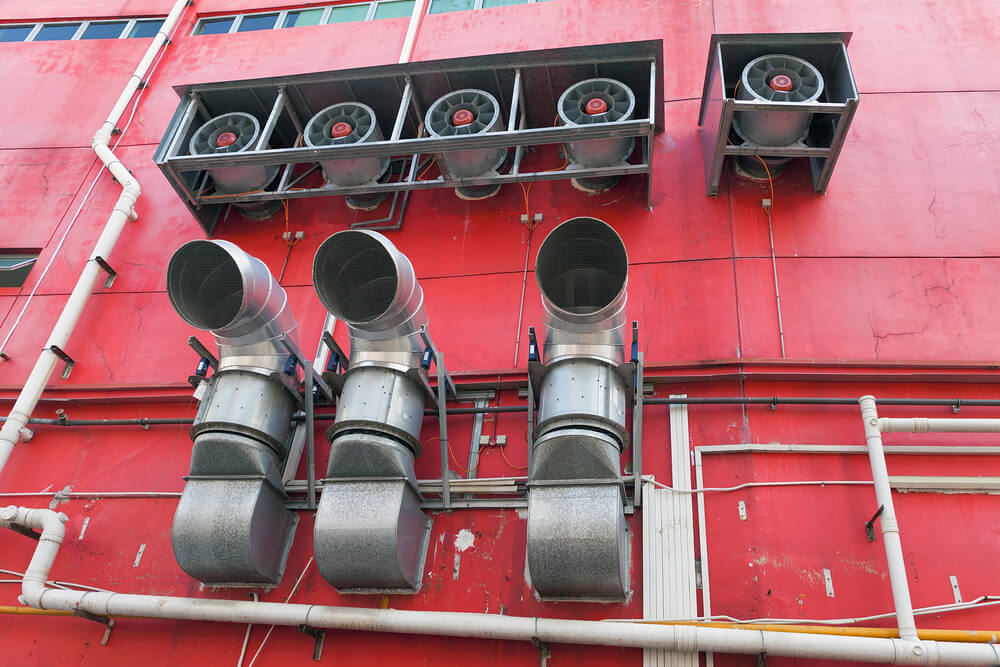Almost all the new houses nowadays are almost airtight. This may sound perfect when we think of energy bills that will be cost-effective, but the disadvantage of these tightly insulated homes can be poor indoor air quality.
Because of the reason that windows and doors are generally kept closed during the day, you may have the idea that moisture and nasty air that may have impurities and bacteria in it may also come inside your house. This can cause a lot of problems, which may include dust mites, health problems, ruined furniture, peeling paint, and whatnot. So, it is very important to take a step to improve the quality of the indoor air in your house. In this article we will discuss types of exhaust fan and their uses in detail.
Types of Exhaust Fans in HVAC

Let us take a look at the types of commercial exhaust fans that are easily available in the market.
Types of exhaust fan for kitchen
As we know that the exhaust fans that are used in the kitchen can help you achieve better ventilation, and it can also help in getting rid of all the smoke and fumes that are caused by the cooking in your commercial or residential kitchens. It also helps in keeping the musty air, dirt, and steam away and keeps your kitchen safe to breathe in. These exhaust fans are usually mounted over the kitchen stove that is inside the hood or any of the window areas and it also reduces moisture levels in your cooking area.
Finolex exhaust fans are considered one of the best in their range of kitchen exhaust fans. Gladiator and Smash are the two types that have a sturdy metal body and a higher air delivery.
Types of exhaust fan for bathroom
You may see every time you take a shower that moisture will certainly build upon the surface of your bathroom tiles and all the mirrors. The proper installation of an exhaust fan in your bathroom will always make sure that the moisture caused by washing is quickly removed. Furthermore, bathroom exhaust fans are usually smaller and comparatively cheaper than any other exhaust fans that are available there in the market. These exhaust fans will help in keeping the bathroom ventilated and smell fresh always.
Finolex bathroom exhaust fans come with silent operation and higher air delivery. Find fresh Co-Axial, Finfresh Axial Nuvo, Finfresh, and Finfresh Axial are the types of bathroom exhaust fans offered in this range.
Types of fans for Home
For your homes, if you want to install a fan in any of the rooms which are considered difficult to ventilate, you can consider an inline exhaust fan. These types of exhaust fan are mounted in between the ducting so that the bad air is eliminated through the ducts.
Ventilation Fan vs Exhaust Fan
No matter how much information we gather about exhaust fans, still, many of us can not speak about the differences between ventilation fans and exhaust fans off the top of their head. Rather, as a matter of fact, many of us would think that they are the same and have no differences among them. Though that is not the truth in fact a myth that many of us believe. Every exhaust fan usually serves specific purposes in both commercial and residential spaces that are crucial for supplying high-quality air throughout an area. Here we will explain the purpose of describing the difference between these two types of intake air fans.
Ventilation Fans
As the name says it all, ventilation fans are usually used for the purpose of ventilating a residential or commercial space. This will always work in order to bring fresh air from the outside and into any confined space. Ventilation fans usually help in circulating the air through the building or home, which would ward off individuals from breathing stuffy, less oxygenated air. Without ventilation fans, you and other people breathing in that particular space will be left breathing air that is not fresh.
Exhaust Fans
So, exhaust fans help in eliminating the pollutants and contaminants that enter the air, in order to provide clean air. These common impurities and pollutants may include smoke, moisture, dust, and many kinds of odors. Smoke that comes from cooking and the moisture that is built from a hot shower can effectively be removed from the air by this type of exhaust fan. If these pollutants are not eliminated from the air proper, they will affect your lungs and possibly harm the breathing due to these harmful particles
Differences between ventilation fans and exhaust fans
Both ventilation fans and exhaust fans function in order to create the freshest, cleanest air possible in the space in which they are installed. The major difference between the two types of fans is their application. While a ventilation fan works to bring clean air into an enclosed space from an outside source, an exhaust fan removes pollutants from the indoor air in a home or commercial space.
Industrial Exhaust Fan Types

Well, an industrial fan is a machine whose major and most important advantage is that it provides and accommodates a large flow of air or gas to many processes that happen in many different industries. This is done by rotating a number of blades that are connected to a hub and shaft and driven by a motor. A blower is the other name for a fan that functions where the resistance to the flow is primarily on the downstream side of the fan.
Most of the industrial fans may be categorized into one of two general types
- Centrifugal Fans
- Axial Fans.
Centrifugal fans are further divided into two categories that are:
- Forward curved centrifugal fans
- Backward curved centrifugal fans
Axial Fans
They are also known as propeller fans these kinds of fans generally move larger volumes of air at comparatively low pressures. Air enters and leaves the fan along the axis of the fan hub. These kinds of fans tend to vary from small applications such as cooling electronics to ventilating buildings and tunnels. The axial design uses axial forces to accomplish the movement of the air or gas, spinning a central hub with blades extending radially from its outer diameter. The fluid is moved analogously to the fan wheel’s shaft or axis of rotation. The axial fan wheel is often contained within a short section of cylindrical ductwork, to which inlet and outlet ducting can be connected. Axial fan types have fan wheels with diameters that usually range from less than a foot (0.3 meters) to over 30 feet (9 m), although axial cooling tower fan wheels may exceed 82 feet (25 m) in diameter.
In the broader vision, axial fans are used where the principal requirement is for a large volume of flow, and the centrifugal design where both flow and higher pressures are required. Axial usually supply framed axial fans, plate axial fans, cased axial fans, and EC high-efficiency axial fans available in standard or specialist specifications.
Centrifugal Fans
The centrifugal design uses the centrifugal force that is usually generated by a rotating disk, with blades that are mounted at right angles to the disk in order to impart movement to the air or gas and it also increases its air pressure very conveniently. The construction of the hub, disk, and blades is known as the fan wheel, and often includes other components with aerodynamic or structural functions. The centrifugal fan wheel is typically contained within a scroll-shaped fan housing. The air or gas inside the spinning fan is thrown off the outside of the wheel, to an outlet at the housing’s largest diameter. This at the same time draws more air or gas into the wheel through the central hole.
There are two main types of centrifugal fans:
Forward Curved Centrifugal Fans
Forward curved centrifugal fans are characterized by having some small blades which are curved in the direction of the rotation. This type of impeller draws most power at “free air” but speeds up as resistance is added and involves a scroll housing to operate efficiently. Air is discharged loosely, usually through a rectangular or circular discharge. The fans used in safety cabinets are large of this type. This develops high pressure fairly quietly, these fans are often used in ducted systems, also taking advantage of their directional delivery.
Backward Curved Centrifugal Fans
Backward curved centrifugal fans are designed with a relatively smaller number of large blades, often in aerofoil sections, which curve away from the direction of rotation. These fans are capable of moving large amounts of air efficiently, making them ideal for applications requiring proper ventilation and high-performance air movement.
The type of fan you choose is crucial, especially in scenarios requiring high-temperature operation. Backward curved fans achieve maximum power and minimum speed overlap at a specific point on the fan curve. When the motor is properly sized to operate at this point, the fan exhibits a “non-overloading characteristic.” These fans may be used with or without a scroll housing, offering great flexibility in system design.
Unlike other fan types, backward curved fans require a higher speed to generate pressure compared to forward-curved fans of similar size. However, their energy efficiency makes them the preferred choice for belt drive systems in large-scale applications. These systems are particularly useful when the goal is to move air effectively while reducing energy consumption.
Applications
Backward curved fans are commonly found in systems designed to improve air quality, ensuring the circulation of clean air and removal of contaminants. In such setups, inline exhaust fans, bathroom exhaust fans, and mounted exhaust fans may be integrated to handle specific ventilation needs. For instance, axial fans are often employed to bring in fresh air or manage airflow in areas where speed and direction are key.
The fan speed is a critical factor in achieving optimal performance. Adjustments to fan speed can help balance air pressure, ensuring efficient operation in both industrial and residential environments. From high-temperature settings to general ventilation systems, backward curved fans are versatile enough to meet diverse requirements while maintaining efficiency.
Conclusion
Choosing the right type of exhaust fan is vital for ensuring efficient air movement and proper ventilation. Whether you’re working with centrifugal fans, axial fans, or belt drive systems, a well-designed fan setup can make a significant difference in maintaining a comfortable and clean environment. These fans not only help in moving air but also play a key role in introducing fresh air, removing stale air, and improving overall air quality.
Common FAQs about Types of Exhaust Fan
Which type of exhaust fan is best?
Centrifugal fans are more efficient at higher static pressures and are quieter than propeller fans. Many centrifugal fan models are designed with motors mounted out of the airstream to ventilate contaminated and high-temperature air.
What type of fan is best suited for keeping a commercial kitchen cool?
The best type of fan for keeping a commercial kitchen cool in hot conditions is a high-powered industrial fan designed for large spaces. Specifically, a wall-mounted fan is ideal for a hot kitchen, as it saves floor space while providing strong airflow. These fans can be positioned strategically to ensure proper ventilation and cooling across the kitchen, especially in areas near cooking appliances where heat buildup is significant.

